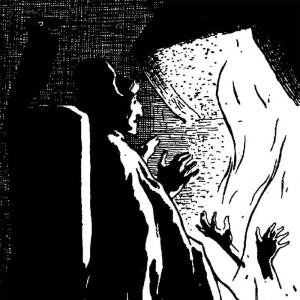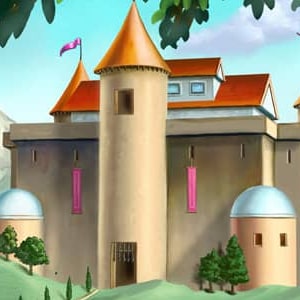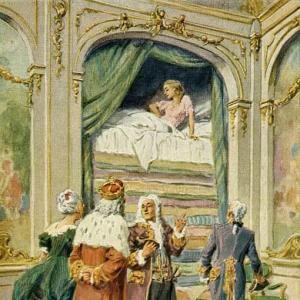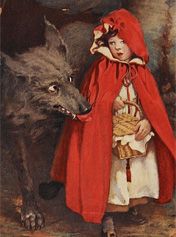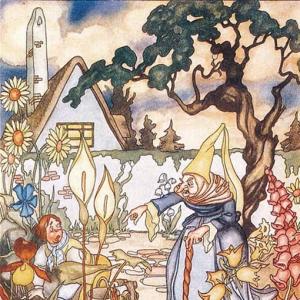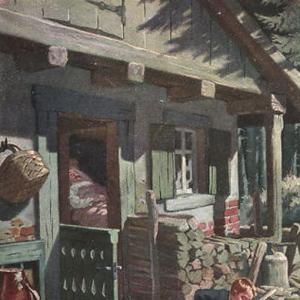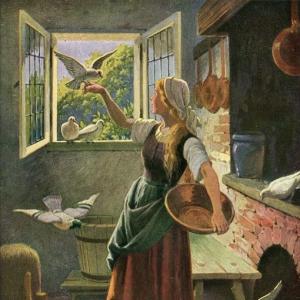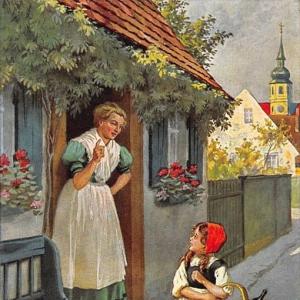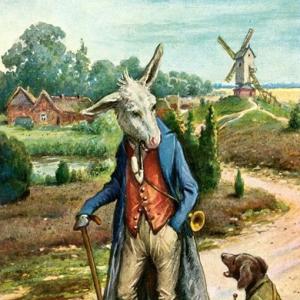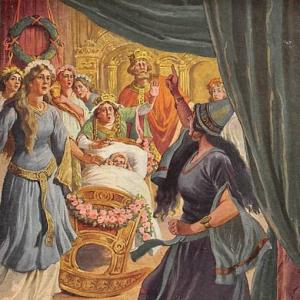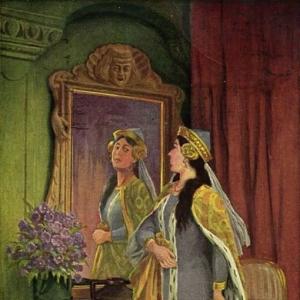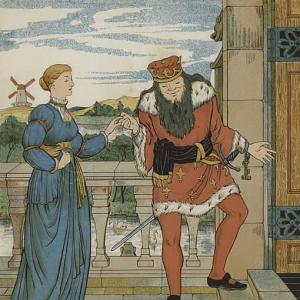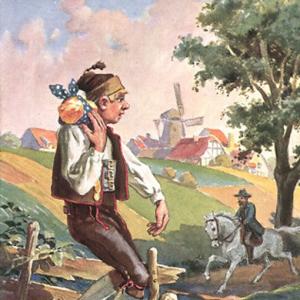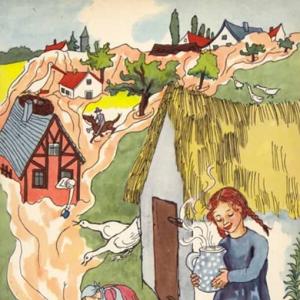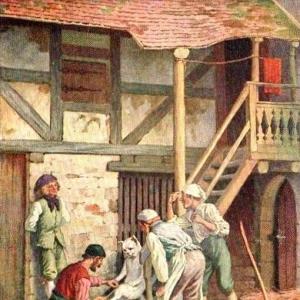Reading time: 12 min
There was a man who had three sons, the youngest of whom was called the Simpleton, and was despised, laughed at, and neglected, on every occasion. It happened one day that the eldest son wished to go into the forest to cut wood, and before he went his mother gave him a delicious pancake and a flask of wine, that he might not suffer from hunger or thirst. When he came into the forest a little old grey man met him, who wished him good day, and said, „Give me a bit of cake out of your pocket, and let me have a drink of your wine. I am so hungry and thirsty.“
But the prudent youth answered, „Give you my cake and my wine? I haven’t got any; be off with you.“ And leaving the little man standing there, he went off. Then he began to fell a tree, but he had not been at it long before he made a wrong stroke, and the hatchet hit him in the arm, so that he was obliged to go home and get it bound up. That was what came of the little grey man. Afterwards the second son went into the wood, and the mother gave to him, as to the eldest, a pancake and a flask of wine. The little old grey man met him also, and begged for a little bit of cake and a drink of wine. But the second son spoke out plainly, saying, „What I give you I lose myself, so be off with you.“
And leaving the little man standing there, he went off. The punishment followed; as he was chopping away at the tree, he hit himself in the leg so severely that he had to be carried home. Then said the Simpleton, „Father, let me go for once into the forest to cut wood; and the father answered, „Your brothers have hurt themselves by so doing; give it up, you understand nothing about it.“ But the Simpleton went on begging so long, that the father said at last, „Well, be off with you. You will only learn by experience.“ The mother gave him a cake (it was only made with water, and baked in the ashes), and with it a flask of sour beer. When he came into the forest the little old grey man met him, and greeted him, saying, „Give me a bit of your cake, and a drink from your flask. I am so hungry and thirsty.“
And the Simpleton answered, „I have only a flour and water cake and sour beer; but if that is good enough for you, let us sit down together and eat.“ Then they sat down, and as the Simpleton took out his flour and water cake it became a rich pancake, and his sour beer became good wine. Then they ate and drank, and afterwards the little man said, „As you have such a kind heart, and share what you have so willingly, I will bestow good luck upon you. Yonder stands an old tree; cut it down, and at its roots you will find some thing,“ and thereupon the little man took his departure. The Simpleton went there, and hewed away at the tree, and when it fell he saw, sitting among the roots, a goose with feathers of pure gold. He lifted it out and took it with him to an inn where he intended to stay the night. The landlord had three daughters who, when they saw the goose, were curious to know what wonderful kind of bird it was, and ended by longing for one of its golden feathers.
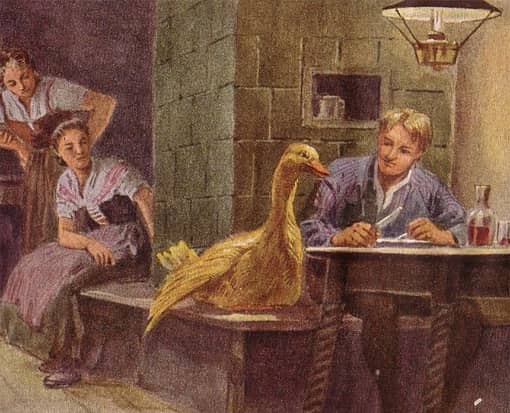 Image: Paul Hey (1867 – 1952)
Image: Paul Hey (1867 – 1952)The eldest thought, „I will wait for a good opportunity, and then I will pull out one of its feathers for myself;“ and so, when the Simpleton was gone out, she seized the goose by its wing – but there her finger and hand had to stay, held fast. Soon after came the second sister with the same idea of plucking out one of the golden feathers for herself; but scarcely had she touched her sister, than she also was obliged to stay, held fast. Lastly came the third with the same intentions; but the others screamed out, „Stay away! for heaven’s sake stay away!“ But she did not see why she should stay away, and thought, „If they do so, why should not I?“ and went towards them. But when she reached her sisters there she stopped, hanging on with them. And so they had to stay, all night.
The next morning the Simpleton took the goose under his arm and went away, unmindful of the three girls that hung on to it. The three had always to run after him, left and right, wherever his legs carried him. In the midst of the fields they met the parson, who, when he saw the procession, said, „Shame on you, girls, running after a young fellow through the fields like this,“ and forthwith he seized hold of the youngest by the hand to drag her away, but hardly had he touched her when he too was obliged to run after them himself.
Not long after the sexton came that way, and seeing the respected parson following at the heels of the three girls, he called out, „Ho, your reverence, whither away so quickly? You forget that we have another christening today,“ and he seized hold of him by his gown; but no sooner had he touched him than he was obliged to follow on too. As the five tramped on, one after another, two peasants with their hoes came up from the fields, and the parson cried out to them, and begged them to come and set him and the sexton free, but no sooner had they touched the sexton than they had to follow on too; and now there were seven following the Simpleton and the goose.
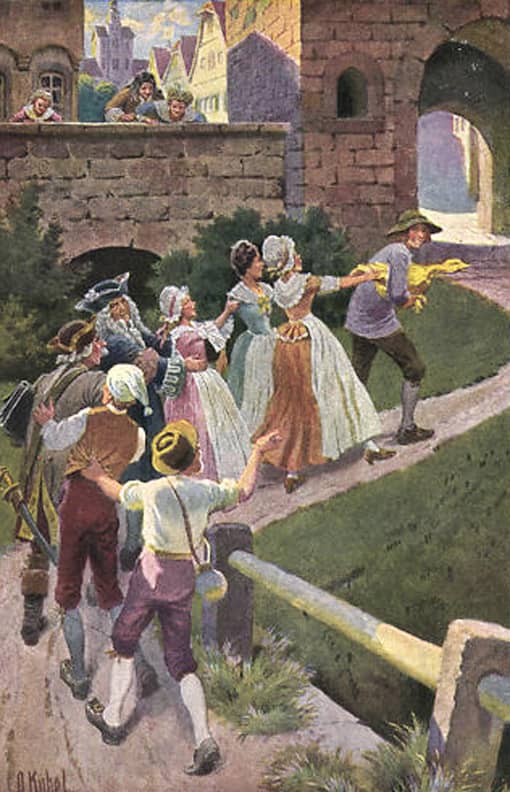 Image: Otto Kubel (1868 – 1951)
Image: Otto Kubel (1868 – 1951)By and by they came to a town where a king reigned, who had an only daughter who was so serious that no one could make her laugh; therefore the king had given out that whoever should make her laugh should have her in marriage. The Simpleton, when he heard this, went with his goose and his hangers-on into the presence of the king’s daughter, and as soon as she saw the seven people following always one after the other, she burst out laughing, and seemed as if she could never stop. And so the Simpleton earned a right to her as his bride; but the king did not like him for a son-in-law and made all kinds of objections, and said he must first bring a man who could drink up a whole cellar of wine.
The Simpleton thought that the little grey man would be able to help him, and went out into the forest, and there, on the very spot where he felled the tree, he saw a man sitting with a very sad countenance. The Simpleton asked him what was the matter, and he answered, „I have a great thirst, which I cannot quench: cold water does not agree with me. I have indeed drunk up a whole cask of wine, but what good is a drop like that?“ Then said the Simpleton, „I can help you; only come with me, and you shall have enough.“ He took him straight to the king’s cellar, and the man sat himself down before the big vats, and drank, and drank, and before a day was over he had drunk up the whole cellar-full.
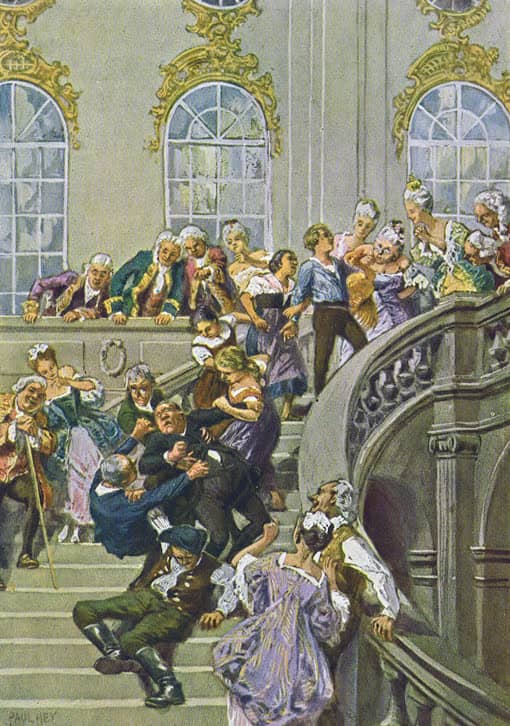 Image: Paul Hey (1867 – 1952)
Image: Paul Hey (1867 – 1952)The Simpleton again asked for his bride, but the king was annoyed that a wretched fellow, called the Simpleton by everybody, should carry off his daughter, and so he made new conditions. He was to produce a man who could eat up a mountain of bread. The Simpleton did not hesitate long, but ran quickly off to the forest, and there in the same place sat a man who had fastened a strap round his body, making a very piteous face, and saying, „I have eaten a whole bakehouse full of rolls, but what is the use of that when one is so hungry as I am?
My stomach feels quite empty, and I am obliged to strap myself together, that I may not die of hunger.“ The Simpleton was quite glad of this, and said, „Get up quickly, and come along with me, and you shall have enough to eat.“ He led him straight to the king’s courtyard, where all the meal in the kingdom had been collected and baked into a mountain of bread. The man out of the forest settled himself down before it and hastened to eat, and in one day the whole mountain had disappeared. Then the Simpleton asked for his bride the third time. The king, however, found one more excuse, and said he must have a ship that should be able to sail on land or on water.
„So soon,“ said he, „as you come sailing along with it, you shall have my daughter for your wife.“ The Simpleton went straight to the forest, and there sat the little old grey man with whom he had shared his cake, and he said, „I have eaten for you, and I have drunk for you, I will also give you the ship; and all because you were kind to me at the first.“ Then he gave him the ship that could sail on land and on water, and when the king saw it he knew he could no longer withhold his daughter. The marriage took place immediately, and at the death of the king the Simpleton possessed the kingdom, and lived long and happily with his wife.
 Learn languages. Double-tap on a word.Learn languages in context with Childstories.org and Deepl.com.
Learn languages. Double-tap on a word.Learn languages in context with Childstories.org and Deepl.com.Backgrounds
Interpretations
Adaptions
Summary
Abstract
Linguistics
„The Golden Goose“ is a German fairy tale collected and published by the Brothers Grimm, Jacob and Wilhelm, in their famous book „Kinder- und Hausmärchen“ (Children’s and Household Tales) in the early 19th century. The Brothers Grimm were German academics and philologists who devoted themselves to collecting, preserving, and documenting oral folktales, which were at risk of being forgotten due to rapid industrialization and urbanization in Europe. Their work has had a profound influence on folklore studies and popular culture. The tale has its origins in European oral storytelling tradition, and like many fairy tales, it has been adapted and retold in various versions over the years.
The fairy tale of „The Golden Goose“ belongs to the Aarne-Thompson-Uther (ATU) classification system as tale type 571, „All Stick Together.“ This classification system, developed by Finnish folklorist Antti Aarne and later expanded by American folklorist Stith Thompson and German folklorist Hans-Jörg Uther, categorizes folktales based on their narrative structure and motifs. In this tale type, the main character encounters various people who attempt to take something from him, only to end up being stuck to an object (in this case, the golden goose) and forced to follow the protagonist.
The story’s primary themes include the value of kindness, the consequences of greed and selfishness, and the power of humor and laughter. These themes are common in many fairy tales and folktales, which often seek to impart moral lessons and wisdom to their audience. The tale has been adapted and retold in various forms, including children’s books, theatrical performances, and film adaptations. The story’s enduring popularity is a testament to the universal appeal of its themes and the captivating nature of the tale. The tale conveys several important themes and moral lessons, such as the value of kindness, the importance of not being greedy, and the rewards that can come from helping others. Like many other fairy tales, it also includes elements of magic, humor, and the triumph of good over evil.
The Golden Goose is a story about a kind-hearted young man named Dummling, who shares his food with a mysterious old man in the woods. In return for his kindness, the old man tells Dummling where to find a golden goose. When he finds the goose, Dummling takes it with him on a journey, during which various people try to steal the golden feathers. However, when they touch the goose, they become stuck to it and are forced to follow Dummling wherever he goes. Eventually, the growing procession of stuck people catches the attention of a princess who has never laughed. The sight of the comical parade makes her laugh, and Dummling wins her hand in marriage as a result. The story concludes with Dummling and the princess living happily ever after.
The origins of „The Golden Goose“ can be traced back to the oral storytelling traditions of the European countryside, where it was passed down through generations. Though the Brothers Grimm collected and recorded the version most familiar today, it is important to note that the story has evolved and been adapted over time, with different versions emphasizing different aspects of the tale. The Brothers Grimm were not the original creators of the stories they collected; rather, they were dedicated to preserving the folktales and oral storytelling traditions of their time. They sought out stories from ordinary people, often from the lower classes, and documented them for future generations. As researchers, they aimed to compile a comprehensive collection of traditional German and European folktales.
„The Golden Goose“ offers several interpretations that can be applied to various aspects of life:
The power of kindness: One of the main messages in the story is the importance of being kind and compassionate towards others. The Simpleton’s kindness towards the old grey man sets him apart from his brothers and ultimately leads to his good fortune. This teaches readers that treating others with kindness can result in positive outcomes. The protagonist, Dummling, is rewarded with the golden goose for his act of kindness in sharing his food with the old man in the woods. This shows that acts of kindness and generosity can lead to unexpected rewards, and highlights the importance of treating others with compassion.
Greed and selfishness: The story also highlights the negative consequences of greed and selfishness, as displayed by the eldest and second sons, the landlord’s daughters, and the other characters who become stuck to the goose. Their actions result in misfortune, while the Simpleton’s generosity brings him success. Those who try to steal the golden goose’s feathers out of greed become stuck to it, leading to a comical and humiliating parade of people. This serves as a cautionary tale, warning against the dangers of greed and the consequences that can come from giving in to selfish desires.
Simplicity and humility: The Simpleton is often ridiculed and underestimated by others due to his simple nature. However, his humility and genuine character prove to be valuable assets that help him triumph in the end. This interpretation suggests that one should not underestimate the worth of simplicity and humility, as they can lead to great achievements.
Transformative power of laughter: The king’s daughter, who is known for her serious demeanor, is changed by the laughter that the Simpleton and his entourage bring her. Laughter is shown to have a healing and transformative power in this story, reminding readers of the importance of joy and humor in life.
Fate and destiny: The Simpleton’s encounters with the old grey man seem to be part of a larger plan or destiny, as the man assists him in overcoming each challenge set by the king. This interpretation suggests that there may be a guiding force in life, and that being kind and compassionate can align one with a positive destiny. The old man in the woods, who could be interpreted as a magical or divine figure, plays a significant role in guiding Dummling’s fate. This suggests that fate or destiny may have a hand in shaping our lives, and that seemingly random encounters can have a profound impact on our futures.
The triumph of the underdog: Dummling is an underdog, a simple and unassuming character who is often underestimated by others. Despite this, he ultimately succeeds where others fail, winning the heart of the princess and achieving happiness. This theme resonates with readers and audiences, as it demonstrates that even the most unlikely individuals can overcome challenges and find success.
The healing power of laughter: The princess in the story has never laughed, and it is only when she sees the absurd parade of people stuck to the golden goose that she finally does. Laughter is portrayed as a powerful, transformative force that can break through sadness and bring joy. This theme reminds us of the importance of laughter and humor in our lives.
Transformative power of love: Dummling’s love for the princess and his kindness towards others ultimately bring happiness to his life. The story implies that love has the power to transform lives and bring about positive change.
These interpretations of „The Golden Goose“ highlight various aspects of human nature and the human experience, as well as the moral lessons that can be drawn from the tale. Like many other fairy tales, this story serves as a vehicle for exploring universal themes and values that resonate across cultures and generations. In summary, „The Golden Goose“ is a rich and multi-layered story that offers valuable lessons on kindness, humility, laughter, and the consequences of one’s actions. These interpretations can serve as reminders of the importance of good character and the potential for positive outcomes when we treat others with compassion and generosity.
„The Golden Goose“ has been adapted in various forms over the years, including books, film, television, and theater. These adaptations often put their own spin on the story, emphasizing different aspects of the tale or modernizing it for contemporary audiences. Here are some specific examples of adaptations.
Illustrated Books: Numerous illustrated editions of „The Golden Goose“ have been published over the years, often as part of larger collections of fairy tales. These editions bring the story to life through vivid artwork and may adapt the text for younger readers. „The Golden Goose: A Grimm’s Fairy Tale Retold“ by Robert D. San Souci (2013): This picture book adaptation of „The Golden Goose“ features illustrations by Quentin Blake and retells the story of the simpleton who receives a golden goose and leads a procession of people who become stuck to it. The book also includes an afterword that discusses the history and significance of the fairy tale.
Films: „The Wonderful World of the Brothers Grimm“ (1962): This American film features a fictionalized account of the Brothers Grimm and includes adaptations of several of their fairy tales, including „The Golden Goose.“ The film uses a combination of live-action and stop-motion animation to tell the story.
TV: „Grimm’s Fairy Tale Classics“ (1987-1989): This Japanese animated television series adapts various fairy tales from the Brothers Grimm, including „The Golden Goose“ in an episode titled „The Golden Bird.“ The story is retold with some changes to the plot, such as the inclusion of talking animals and other magical elements. „SimsalaGrimm“ (1999-2010): This German animated television series adapts a variety of Grimm’s fairy tales, including „The Golden Goose“ in an episode with the same title. The series often adds a modern twist to the classic tales, with the protagonists Yoyo and Doc Croc traveling to the world of fairy tales to help solve problems and set things right. „Jim Henson’s The Storyteller: Greek Myths“ (1990): Although primarily focused on Greek mythology, this British-American television series includes an episode titled „Theseus and the Minotaur,“ which incorporates elements of „The Golden Goose.“ In the episode, Theseus encounters a golden goose that causes people to become stuck to it, similar to the events in the original fairy tale. „Once Upon a Time“ (2011-2018): This popular television series features various fairy tale characters, including a version of „The Golden Goose“ story. In the show, the golden goose is a magical creature that can turn people into gold and is sought after by various characters. The adaptation explores themes of power, greed, and the consequences of one’s actions.
Theater: „The Golden Goose“ has been adapted for the stage in various forms, including plays, musicals, and puppet shows. These productions often use creative approaches to portray the magical elements of the story and may reinterpret the tale to emphasize different themes or lessons.
These adaptations of „The Golden Goose“ demonstrate the enduring appeal of the fairy tale and its ability to inspire creativity across different media. While the core story remains the same, each adaptation brings its unique perspective and interpretation, ensuring that the tale continues to resonate with new generations of readers and audiences. These are just a few examples of the many adaptations of „The Golden Goose.“ The story’s enduring popularity and universal themes continue to inspire new retellings and adaptations across various media.
„The Golden Goose“ is a fairy tale by Brothers Grimm, which revolves around a simpleton who, through kindness and a series of unexpected events, earns the hand of a princess and eventually the kingdom. The story begins with a man who has three sons. The youngest, called the Simpleton, is ridiculed and neglected by his family. One day, the eldest son goes to the forest to cut wood and encounters a little old grey man. The man asks for food and drink, but the eldest son refuses and leaves him. As a result, the eldest son injures himself while cutting wood and is forced to go home. The same fate befalls the second son, who also refuses to help the old man.
The Simpleton then decides to go into the forest to cut wood. His mother gives him a simple flour-and-water cake and sour beer. He encounters the little old grey man, and unlike his brothers, he willingly shares his food and drink. The man rewards the Simpleton’s kindness, directing him to an old tree, where he finds a golden goose. The Simpleton takes the golden goose to an inn, where the landlord’s three daughters become curious about the bird. Each girl tries to steal a golden feather, but they become stuck to the goose and each other. The next day, the Simpleton leaves the inn with the goose, unknowingly dragging the three girls, a parson, a sexton, and two peasants behind him.
They arrive in a kingdom where the king has decreed that whoever makes his serious daughter laugh will marry her. The sight of the Simpleton and his entourage makes the princess laugh, and the Simpleton claims his right to marry her. The king, however, is not pleased and sets several challenges for the Simpleton: find a man who can drink a cellar of wine, find a man who can eat a mountain of bread, and produce a ship that sails on land and water. The Simpleton seeks the help of the little old grey man, who provides a man for each task. After completing all challenges, the Simpleton receives the king’s daughter in marriage. Eventually, the Simpleton inherits the kingdom and lives happily ever after with his wife. In this fairy tale, the theme of kindness and its rewards is prevalent, as the Simpleton’s good-hearted actions lead him to overcome challenges and attain success.
„The Golden Goose“ is a fairy tale collected by the Brothers Grimm about a kind-hearted young man named Dummling. In the story, Dummling shares his food with a mysterious old man in the woods, who, in return, tells him where to find a golden goose. Dummling discovers the goose and takes it with him on his journey. As he travels, various people attempt to steal the golden feathers but become stuck to the goose when they touch it. The growing procession of people stuck to the goose catches the attention of a princess who has never laughed. When she sees the comical parade, she laughs for the first time, and as a reward, Dummling is allowed to marry her. The story concludes with Dummling and the princess living happily ever after, emphasizing the themes of kindness, the consequences of greed, and the triumph of the underdog.
A linguistic analysis of the Brothers Grimm’s „The Golden Goose“ offers a fascinating look at language use, structure, and thematic elements typical of fairy tales.
Narrative Structure
Three Brothers Motif: The story follows a traditional „rule of three“ structure, a common element in fairy tales. The youngest sibling, often perceived as foolish or simple, ultimately succeeds where the others fail.
Sequential Trials: The protagonist faces a series of challenges or tests that must be overcome to achieve the goal, in this case, the Simpleton needing to meet the king’s conditions.
Language and Style
Repetitive and Formulaic Language: The tale uses repetitive phrasing („the little old grey man met him“) which is characteristic of oral storytelling, making the story easier to remember and engage with.
Contrast and Parallelism: The actions and responses of the three brothers are presented in a parallel manner, highlighting the differences in their character and fate.
Simple and Direct Speech: Dialogues are direct and uncomplicated, reflecting the clear moral and ethical lessons common in fairy tales.
Themes and Morals
Kindness and Generosity: A central theme is the reward of kindness. The Simpleton’s willingness to share what little he has results in eventual prosperity and happiness.
Underdog Triumph: The story promotes the idea that those underestimated or undervalued (the Simpleton) can achieve great things through perseverance and virtue.
Consequences: The misfortunes that befall the brothers who refuse to help the old man underscore the moral lesson that selfishness has negative consequences.
Symbolism
Golden Goose: Represents unexpected fortune and the reward of simple goodness. Its ability to make people stick symbolizes the binding nature of greed.
Forest: A traditional setting in fairy tales symbolizing the unknown or a place of tests and transformation.
The Little Old Grey Man: A classic fairy tale figure who bestows magic or wisdom upon those who prove themselves worthy through their actions.
Social Commentary
Critique of Class and Intelligence Assumptions: The tale challenges societal assumptions about intelligence and worthiness. The Simpleton, underestimated by his family, proves to be the most capable and honorable.
Authority and Power Dynamics: The king’s reluctance to accept the Simpleton reflects the resistance to changing social hierarchies, which is ultimately overcome by tenacity and resourcefulness.
„The Golden Goose“ stands as a rich example of the traditional fairy tale genre, encapsulating complex themes within simple structures, and delivering moral lessons through engaging narrative and linguistic features.
Information for scientific analysis
Fairy tale statistics | Value |
|---|---|
| Number | KHM 64 |
| Aarne-Thompson-Uther-Index | ATU Typ 571 |
| Translations | DE, EN, EL, DA, ES, FR, PT, HU, IT, JA, NL, PL, RO, RU, TR, VI, ZH |
| Readability Index by Björnsson | 36.8 |
| Flesch-Reading-Ease Index | 75 |
| Flesch–Kincaid Grade-Level | 9.3 |
| Gunning Fog Index | 11.8 |
| Coleman–Liau Index | 7.3 |
| SMOG Index | 9.5 |
| Automated Readability Index | 10.2 |
| Character Count | 8.334 |
| Letter Count | 6.401 |
| Sentence Count | 62 |
| Word Count | 1.628 |
| Average Words per Sentence | 26,26 |
| Words with more than 6 letters | 172 |
| Percentage of long words | 10.6% |
| Number of Syllables | 2.025 |
| Average Syllables per Word | 1,24 |
| Words with three Syllables | 73 |
| Percentage Words with three Syllables | 4.5% |
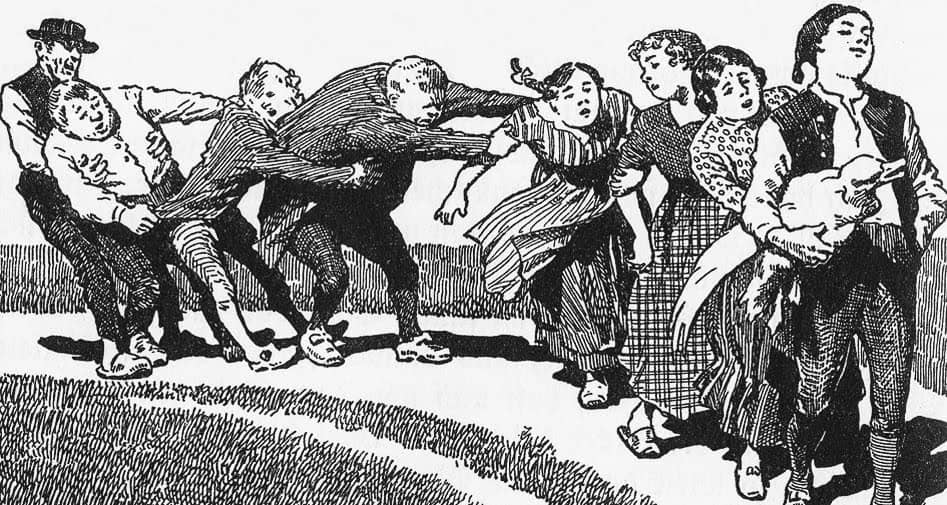
 Facebook
Facebook  Whatsapp
Whatsapp  Messenger
Messenger  Telegram
Telegram Reddit
Reddit